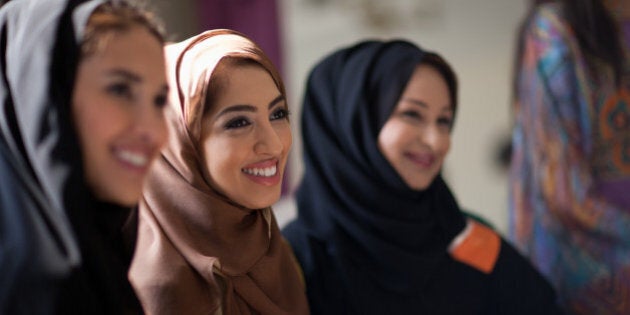
The headscarf worn by Muslim women is often a subject of immense debate in the media. It is donned for various reasons from the personal to the political. It is imposed on many but freely adopted by others.
A piece of clothing that should ideally be an issue of freedom of choice and expression has been heavily politicized.
This has led to the oppression of Muslim women even in Canada. It is enforced as a religious obligation, sometimes under great moral duress. A young Muslim Canadian was murdered for not wearing it. On the other hand, other Muslim women, who elect to be visible by donning the headscarf, have been physically assaulted.
A vast majority of Muslims believe in the obligation of the headscarf. How much of that stems from the rise of populist Islamic movements since the 1970s may be gauged from Leila Ahmed's book "A Quiet Revolution."
Muslim feminists correctly argue that it is a matter concerning women, who have been given dictations by men. Indeed, the case for obligation is predominately made by male scholars and by male chauvinists who promote inane memes comparing women without headscarves to uncovered lollipops.
Projecting themselves as custodians of Islamic values, they often sideline contrarian positions as stemming from secular or feminist values.
However, it is illustrative to highlight the voices of the few Muslim male scholars who support the permissibility of not wearing the headscarf on the basis of Islamic hermeneutics. This showcases diversity of Muslim thought and offers a richer gamut of choice in Islam.
The theological arguments of five high profile Muslim scholars are highlighted below.
1. Khaled Abou El-Fadl
El-Fadl finds it ironic that the headscarf has become "symbolic of Islamic identity," as for him it is "not at the core of the Islamic faith." He critiques the predominant Muslim position of viewing the khimar (veil) as a piece of cloth that covers the head and face or just the head. For El-Fadl, evidence does not exist that pre-Islamic women in Mecca covered their face or hair. He even mentions a great descendant of the Prophet known as Fatima al-Kubra who refused to cover her hair along with the noble women of her time. Moreover, he also points out that slave women had their heads uncovered so the issue for classical jurists on the dress code was not sexual seduction but rather social status.
El-Fadl mentions that the illa (operative cause) for the injunction to cover was to protect women from harm and to avoid undue attention from mischief mongors. He also states that the ma'ruf (generally accepted as good) and the munkar (socially recognized as unacceptable) are based on pragmatic and practical experience. Therefore, he argues that if the headscarf itself causes women to stand out and put them in the way of harm and if uncovering the head is not considered socially immodest or licentious then it would be permissible for Muslim women to not wear the headscarf.
2. Javed Ahmad Ghamidi
Like El-Fadl, Ghamidi opines there were injunctions exclusive for the wives of the Prophet. He argues that there are only four instructions that pertain to Muslim women. These include lowering the gaze, wearing modest clothing, covering the bosom with a piece of cloth and not displaying ornamental embellishments before unrelated men. No other injunction other than these has been imposed on Muslim women.
Ghamidi's affiliates like Farhad Shafti have clearly mentioned that the khimar (veil) was neither a religious act nor did it pertain to modesty and even the Qur'an uses the word without legal connotations. Another affiliate, Moiz Amjad also argues that, "Islam does not make it mandatory for women to cover their heads". He succinctly states that headscarf is not part of the sharia and that donning it is a personal choice.
More from HuffPost Canada:
3. Abdullah bin Bayyah
Bin Bayyah adopts an approach based on necessity. He argues that hardships allow for uncovering of body parts and mentioned how the shins of two of the Prophet's wives, Aishah and Umm Salamah, were uncovered when they were giving water to wounded soldiers on the battlefield. He also mentions the minority position of Ibn Ashur that women may uncover their hair in public. Bin Bayyah's student Hamza Yusuf even asserts that:
"The laws are there to serve human beings; we are not there to serve the law. We are there to serve Allah, and that is why whenever the law does not serve you, you are permitted to abandon it, and that is actually following the law. ... The law is for our benefit, not for our harm. Therefore, if the law harms us, we no longer have to abide by it."
4. Ahmad Ghabel
The late Shia cleric, who had the prominent title of Hojjat el-Islam (authority on Islam), offered ten arguments in support of the viewpoint that covering the head was not obligatory but recommended. He opined that there was no consensus amongst jurists as to whether hair constituted the awrah (intimate parts) that must be covered.
5. Nasr Abu Zayd
According to the late Abu Zayd, both the awrah (intimate parts) and the hijab (veil) are subject to socio-cultural norms and therefore are changeable and not fixed. He opined that both are not legislated by Islam but are rather specific to the Arab culture.
Like these five scholars, others like Abdullah al-Judai, the late Zaki Badawi, the late Gamal al-Banna, Khalid Zaheer and Shehzad Saleem amongst others have also adopted positions in stark contrast to the current mainstream position.
In essence, these opinions serve to offer a richer set of information in support of freedom of choice and expression. The headscarf pertains to women. It is Muslim women who decide to reject the headscarf despite apostasy threats or wear it in the face of potential harassment and assault. The decision is theirs and theirs alone.
Follow HuffPost Canada Blogs on Facebook
Also on HuffPost:
